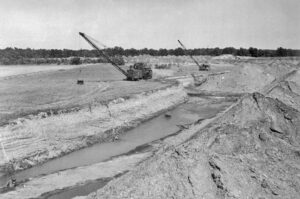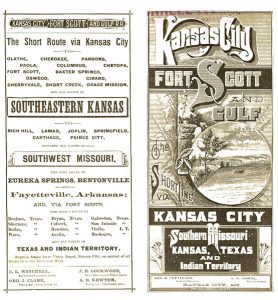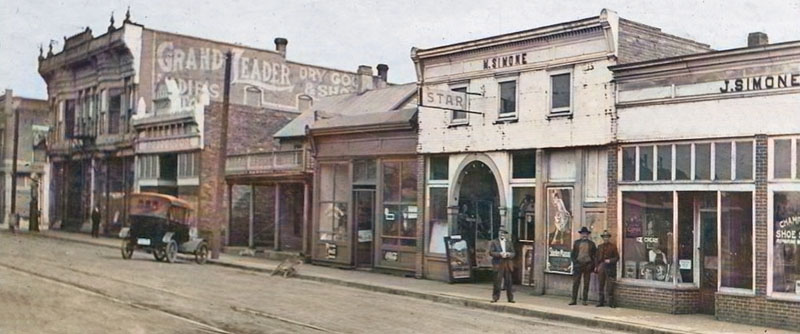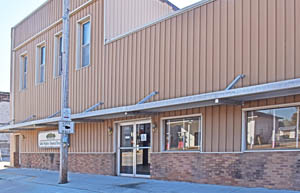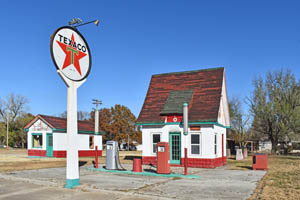Weir, Kansas, also known as Weir City, is a small town in Cherokee County. As of the 2020 census, its population was 569.
A former coal-mining town, Weir was founded and laid out in 1872 and named for landowner T. M. Weir, who donated 40 acres for the townsite. Weir, a miner and coal dealer, had come to Kansas from Illinois in 1871 and opened mines as soon as he arrived. He also owned and ran an 80-acre farm.
Weir was one of the first locations in Kansas where coal was mined commercially. The area was undermined at a depth of about 30 feet, where coal was mined from a four-foot thick vein. T. M. Weir opened the first store in the new town, gave the right-of-way to the Kansas City, Fort Scott, and Gulf Railroad, and donated lots for the various churches of the town.
Among the first to open coal mines were Fred Blattner, the Oswego Coal Company, and Bovard & Dixon. Then came Keith & Perry, and later The Kansas & Texas Coal Company. Other early residents included P. E. Brady, John Sullivan, John Hoffman, and G. D. Sams. Afterward, William Hamilton, Edward Baker, Nick Smith, E. E. Holt, Peter Smith, Joseph Bennett and Robert Hogg came.
In 1873, the Weir City Zinc Company was the first zinc smelter to open at Weir.
A post office was established on January 15, 1875. In 1880, the population was 400.
Unfortunately, the first settlers and mine operators did not get the best returns from their labor. Coal was produced at nominal prices so low that the operators had a narrow profit margin. However, as the population of the eastern part of the State increased, and the enlargement of railroad systems went on, the demand for fuel was proportionately more significant. With the greater demand, profits increased.
The first physicians were Dr. J. Knox Barney, Dr. Bailey, and Dr. C. W. Hoag. In 1890, the town had grown to 2,138,
In 1899, more than 200 African-American miners traveled to Weir from Pana, Illinois, after being attacked by white union members in the Pana Riot during a coal mining strike. They were eager for work and unwilling to return to Alabama, where they had been recruited.
Weir’s population peaked in 1900 at 2,977. A fire department was maintained at that time, and the city streets were well-lighted. A large ice plant was in successful operation, supplying the local demand and shipping large quantities to other towns and cities. Three fine school buildings were in different parts of the city, with 17 teachers employed. Baptist, Catholic, Methodist, and Presbyterian churches had been built. The city also boasted several organizations, including the Masons, Odd Fellows, Knights of Pythias, Sons and Daughters of Justice, Knights and Ladies of Security, Rebekahs, Order of the Eastern Star, and the Degree of Honor.
The building of the Weir City branch of the Kansas City, Fort Scott & Memphis Railroad, which left the main line at Scammon, ran through Weir and Pittsburg, and returned to the main line at Girard, gave an impetus to the growth of the place and vastly increased its commercial importance. The city also had railroad connections west with Parsons, Kansas, and to the gas and oil fields in the area.
In 1910, it was located on the St. Louis & San Francisco Railroad, and excellent quality coal continued to be mined in the vicinity and shipped from Weir in large quantities. At that time, it was an incorporated city with waterworks, electric lights, a fire department, an opera house, a bank, the Journal newspaper, a feed mill, a public library, schools and churches, telegraph and express offices, and an international money order post office with three rural routes. Its population was 2,289.
Today, the community has a bank, a library, and several other small businesses. The nearby Mined Land Wildlife Area provides many camping, hunting, and fishing opportunities.
Weir is 14 miles north of Columbus on Highway K-103.
©Kathy Alexander/Legends of Kansas, August 2023.
Also See:
Places & Destinations in Kansas
Sources:
Allison, Nathaniel Thompson; History of Cherokee County, Kansas, and Representative Citizens, Biographical Publishing Co., Chicago, IL: 1904.
Blackmar, Frank W.; Kansas: A Cyclopedia of State History, Vol I; Standard Publishing Company, Chicago, IL 1912.
Cutler, William G; History of Kansas; A. T. Andreas, Chicago, IL, 1883.
Wikipedia


